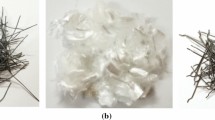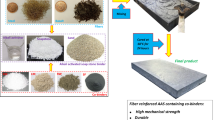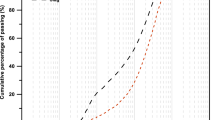Abstract
Alkali-activated materials are gaining attention as a sustainable alternative to cement-based materials over the past years and studies on their fracture response are scarce. This paper presents the fracture behavior of alkali-activated fiber-reinforced basalt powder/slag blend mortars. Fracture characteristics such as the fracture toughness—KICini and KICun—of the alkali-activated basalt powder/slag mortar mixes were determined using the double-K fracture model. Basalt fibers and a combination of basalt + polypropylene fibers (hybrid) were used to enhance the fracture properties of the mixes, and it was found that the basalt powder/slag binary mortars achieved performance comparable with that of cement-based systems in terms of compressive strength, fracture toughness, and fracture energy. The alkali-activated basalt powder/slag mixes exhibited good mechanical performance, which as established previously was due to the beneficial silicium and calcium-based resources and the synergy between the basalt powder and the slag. Incorporating basalt fibers was effective in improving flexural strength and fracture toughness significantly, and they contributed much more than the hybrid fibers did. On the other hand, incorporating hybrid fibers improved the fracture energy significantly. The fiber–matrix interface and the fiber behavior under flexure were visualized using scanning electron microscopy. The fiber–matrix bonding mechanism showed that the polypropylene fibers tended to cluster, resulting in less-improved fracture toughness compared to that with basalt fibers. The outcomes of this study show that basalt powder/slag blends can be used as structural materials: they have fracture characteristics similar to those of cement-based systems and incorporating basalt and hybrid fibers improve their fracture characteristics.











Similar content being viewed by others

References
Shi C, Jiménez AF, Palomo A (2011) New cements for the 21st century: the pursuit of an alternative to Portland cement. Cem Concr Res 41:750–763. https://doi.org/10.1016/j.cemconres.2011.03.016
Akbarpour A, Mahdikhani M, Moayed RZ (2021) Mechanical behavior and permeability of plastic concretecontaining natural zeolite under triaxial and uniaxial compression.pdf. J Mater Civ Eng 04021453-1. https://doi.org/10.1061/(ASCE)MT.1943-5533.0004093
Shi C, Roy D, Krivenko P (2003) Alkali-activated cements and concretes. CRC Press
Puertas F, Martínez-Ramírez S, Alonso S, Vázquez T (2000) Alkali-activated fly ash/slag cements. Cem Concr Res. 30(10):1625–1632. https://doi.org/10.1016/s0008-8846(00)00298-2
Zhang Z, Provis JL, Reid A, Wang H (2014) Fly ash-based geopolymers: the relationship between composition, pore structure and efflorescence. Cem Concr Res 64:30–41. https://doi.org/10.1016/j.cemconres.2014.06.004
Li N, Shi C, Wang Q et al (2017) Composition design and performance of alkali-activated cements. Mater Struct Constr 50:1–11. https://doi.org/10.1617/s11527-017-1048-0
Akturk B, Kızılkanat AB, Kabay N, Akyuncu V (2021) Utilization of basalt powder as geopolymeric binder. In: International conference on “cement - based materials tailored for a sustainable future sustainable future. Istanbul, pp 491–497
Gill R (2011) Igneous Rocks and processes: a practical guide. John Wiley & Sons.
Esafian M, Hourani M, Khoury H et al (2017) Synthesis of hydroxysodalite zeolite by alkali-activation of basalt powder rich in calc-plagioclase. Adv Powder Technol 28:473–480. https://doi.org/10.1016/j.apt.2016.11.002
Ismael Saraya ME-S, El-Fadaly E (2017) Preliminary study of alkali activation of basalt: effect of NaOH concentration on geopolymerization of basalt. J Mater Sci Chem Eng 5:58–76. https://doi.org/10.4236/msce.2017.511006
Ke G, Shen H, Yang P (2019) Synthesis of X-zeolite from waste basalt powder and its influencing factors and synthesis mechanism. Materials (Basel) 12:3895. https://doi.org/10.3390/ma12233895
Venyite P, Makone CE, KAze RC, et al (2021) Effect of combined metakaolin and basalt powder additions to laterite-based geopolymers activated by rice husk ash (RHA)/NaOH solution. Silicon 1–20. https://doi.org/10.1007/s12633-021-00950-7
Ahmad J, Zhou Z (2022) Mechanical properties of natural as well as synthetic fiber reinforced concrete: a review. Constr Build Mater 333:127353. https://doi.org/10.1016/j.conbuildmat.2022.127353
Kazmi SMS, Munir MJ, Wu Y-F, Patnaikuni I (2018) Effect of macro-synthetic fibers on the fracture energy and mechanical behavior of recycled aggregate concrete. Constr Build Mater 189:857–868. https://doi.org/10.1016/j.conbuildmat.2018.08.161
Noushini A, Hastings M, Castel A, Aslani F (2018) Mechanical and flexural performance of synthetic fibre reinforced geopolymer concrete. Constr Build Mater 186:454–475. https://doi.org/10.1016/j.conbuildmat.2018.07.110
Mwangi J (2001) Flexural behavior sisal fiber reinforced concrete beams. University of California
Larena A, Pinto G (1993) The effect of surface roughness and crystallinity on the light scattering of polyethylene tubular blown films. Polym Eng Sci 33:742–747. https://doi.org/10.1002/pen.760331204
Ranjbar N, Mehrali M, Benhia A, Javadi Pordsari A (2016) A comprehensive study of the polypropylene fiber reinforced fly ash based geopolymer. PLoS ONE 11:e0147546. https://doi.org/10.1371/journal.pone.0147546
Mu B, Meyer C, Shimanovich S (2002) Improving the interface bond between fiber mesh and cementitious matrix. Cem Concr Res 32:783–787. https://doi.org/10.1016/S0008-8846(02)00715-9
Richardson AE (2006) Compressive strength of concrete with polypropylene fibre additions. Struct Surv 24:138–153. https://doi.org/10.1108/02630800610666673
Banthia N, Gupta R (2006) Influence of polypropylene fiber geometry on plastic shrinkage cracking in concrete. Cem Concr Res 36:1263–1267. https://doi.org/10.1016/j.cemconres.2006.01.010
Liew KM, Akbar A (2020) The recent progress of recycled steel fiber reinforced concrete. Constr Build Mater 232:117232. https://doi.org/10.1016/j.conbuildmat.2019.117232
Dhand V, Mittal G, Rhee KY et al (2015) A short review on basalt fiber reinforced polymer composites. Compos Part B Eng 73:166–180. https://doi.org/10.1016/j.compositesb.2014.12.011
Sim J, Park C, Moon DY (2005) Characteristics of basalt fiber as a strengthening material for concrete structures. Compos Part B Eng 36:504–512. https://doi.org/10.1016/j.compositesb.2005.02.002
Di Ludovico M, Prota A, Manfredi G (2010) Structural upgrade using basalt fibers for concrete confinement. J Compos Constr 14:541–552. https://doi.org/10.1061/(asce)cc.1943-5614.0000114
Dias DP, Thaumaturgo C (2005) Fracture toughness of geopolymeric concretes reinforced with basalt fibers. Cem Concr Compos 27:49–54. https://doi.org/10.1016/j.cemconcomp.2004.02.044
Kizilkanat AB, Kabay N, Akyüncü V et al (2015) Mechanical properties and fracture behavior of basalt and glass fiber reinforced concrete: an experimental study. Constr Build Mater 100:218–224. https://doi.org/10.1016/j.conbuildmat.2015.10.006
Gültekin A, Beycioğlu A, Arslan ME et al (2022) Fresh properties and fracture energy of basalt and glass fiber–reinforced self-compacting concrete. J Mater Civ Eng 34:1–9. https://doi.org/10.1061/(asce)mt.1943-5533.0004043
Wang Y, Hu S, He Z (2021) Mechanical and fracture properties of geopolymer concrete with basalt fiber using digital image correlation. Theor Appl Fract Mech 112:102909. https://doi.org/10.1016/j.tafmec.2021.102909
Smarzewski P (2019) Influence of basalt-polypropylene fibres on fracture properties of high performance concrete. Compos Struct 209:23–33. https://doi.org/10.1016/j.compstruct.2018.10.070
Zhou X, Zeng Y, Chen P et al (2021) Mechanical properties of basalt and polypropylene fibre-reinforced alkali-activated slag concrete. Constr Build Mater 269:121284. https://doi.org/10.1016/j.conbuildmat.2020.121284
Jiang C, Fan K, Wu F, Chen D (2014) Experimental study on the mechanical properties and microstructure of chopped basalt fibre reinforced concrete. Mater Des 58:187–193. https://doi.org/10.1016/j.matdes.2014.01.056
Li W, Xu J (2009) Mechanical properties of basalt fiber reinforced geopolymeric concrete under impact loading. Mater Sci Eng A 505:178–186. https://doi.org/10.1016/j.msea.2008.11.063
Li W, Xu J (2009) Impact characterization of basalt fiber reinforced geopolymeric concrete using a 100-mm-diameter split Hopkinson pressure bar. Mater Sci Eng A 513–514:145–153. https://doi.org/10.1016/j.msea.2009.02.033
Wang Y, Hu S, Sun X (2022) Experimental investigation on the elastic modulus and fracture properties of basalt fiber–reinforced fly ash geopolymer concrete. Constr Build Mater 338:127570. https://doi.org/10.1016/j.conbuildmat.2022.127570
Xu S, Reinhardt HW (2000) A simplified method for determining double-K fracture parameters for three-point bending tests. Int J Fract 104:181–209. https://doi.org/10.1023/A:1007676716549
Xu S, Reinhardt HW (1999) Determination of double-K criterion for crack propagation in quasi-brittle fracture, Part I: experimental investigation of crack propagation. Int J Fract 98:111–149. https://doi.org/10.1023/A:1018668929989
Japanese Concrete Institute (2003) Method of test for fracture energy of concrete by use of notched beam. 2:1–14
Bakharev T, Sanjayan JG, Cheng YB (2000) Effect of admixtures on properties of alkali-activated slag concrete. Cem Concr Res 30:1367–1374. https://doi.org/10.1016/S0008-8846(00)00349-5
Krizan D, Zivanovic B (2002) Effects of dosage and modulus of water glass on early hydration of alkali-slag cements. Cem Concr Res 32:1181–1188. https://doi.org/10.1016/S0008-8846(01)00717-7
Fang G, Kei Ho W, Tu W, Zhang M (2018) Workability and mechanical properties of alkali-activated fly ash-slag concrete cured at ambient temperature. Constr Build Mater 172:476–487. https://doi.org/10.1016/j.conbuildmat.2018.04.008
Dias DP, Thaumaturgo C, Meddah MS et al (2009) Influence of Na2O content and Ms (SiO2/NamO) of alkaline activator on workability and setting of alkali-activated slag paste. Cem Concr Res 32:1367–1374. https://doi.org/10.3390/ma12132072
Akbarpour A, Mahdikhani M, Moayed RZ (2022) Effects of natural zeolite and sulfate ions on the mechanical properties and microstructure of plastic concrete. Front Struct Civ Eng 16:86–98. https://doi.org/10.1007/s11709-021-0793-x
Akbarpour A, Mahdikhani M (2022) Effects of natural zeolite and sulfate environment.pdf. Eur J Environ Civ Eng. https://doi.org/10.1080/19648189.2022.2075940
Duxson P, Fernández-Jiménez A, Provis JL et al (2007) Geopolymer technology: the current state of the art. J Mater Sci 42:2917–3233. https://doi.org/10.1007/s10853-006-0637-z
Aisheh YIA, Dawood Sulaiman Atrushi MHA, Qaidi S, Tayeh BA (2022) Influence of polypropylene and steel fibers on the mechanical properties of ultra-high-performance fiber-reinforced geopolymer concrete. Case Stud Constr Mater 17:e01234. https://doi.org/10.1016/j.cscm.2022.e01234
Topçu IB, Canbaz M (2007) Effect of different fibers on the mechanical properties of concrete containing fly ash. Constr Build Mater 21:1486–1491. https://doi.org/10.1016/j.conbuildmat.2006.06.026
Farinha CB, de Brito J, Veiga R (2021) Incorporation of high contents of textile, acrylic and glass waste fibres in cement-based mortars: ınfluence on mortars’ fresh, mechanical and deformability behaviour. Constr Build Mater 303:124424. https://doi.org/10.1016/j.conbuildmat.2021.124424
Meddah MS, Bencheikh M (2009) Properties of concrete reinforced with different kinds of industrial waste fibre materials. Constr Build Mater 23:3196–3205. https://doi.org/10.1016/j.conbuildmat.2009.06.017
Belkadi AA, Aggoun S, Amouri C et al (2018) Effect of vegetable and synthetic fibers on mechanical performance and durability of Metakaolin-based mortars. J Adhes Sci Technol 32:1670–1686. https://doi.org/10.1080/01694243.2018.1442647
Akturk B, Akca AH, Kizilkanat AB (2020) Fracture response of fiber-reinforced sodium carbonate activated slag mortars. Constr Build Mater 241. https://doi.org/10.1016/j.conbuildmat.2020.118128
Tajunnisa Y, Sutrisno M, Sigeishi M (2019) Impact of PVA fiber as fine aggregate replacement in alkali-activated fly ash on flow rate, mechanical properties and drying shrinkage. Int J Geomater 17:217–223. https://doi.org/10.21660/2019.63.90227
Koenig A, Wuestemann A, Gatti F et al (2019) Flexural behaviour of steel and macro-PP fibre reinforced concretes based on alkali-activated binders. Constr Build Mater 211:583–593. https://doi.org/10.1016/j.conbuildmat.2019.03.227
Abdollahnejad Z, Mastali M, Woof B, Illikainen M (2020) High strength fiber reinforced one-part alkali activated slag/fly ash binders with ceramic aggregates: microscopic analysis, mechanical properties, drying shrinkage, and freeze-thaw resistance. Constr Build Mater 241:118129. https://doi.org/10.1016/j.conbuildmat.2020.118129
Ranjbar N, Talebian S, Mehrali M et al (2016) Mechanisms of interfacial bond in steel and polypropylene fiber reinforced geopolymer composites. Compos Sci Technol 122:73–81. https://doi.org/10.1016/j.compscitech.2015.11.009
Puertas F, Amat T, Fernández-Jiménez A, Vázquez T (2003) Mechanical and durable behaviour of alkaline cement mortars reinforced with polypropylene fibres. Cem Concr Res 33:2031–2036. https://doi.org/10.1016/S0008-8846(03)00222-9
Wang JY, Banthia N, Zhang MH (2012) Effect of shrinkage reducing admixture on flexural behaviors of fiber reinforced cementitious composites. Cem Concr Compos 34:443–450. https://doi.org/10.1016/j.cemconcomp.2011.12.004
Shafiq N, Ayub T, Khan SU (2016) Investigating the performance of PVA and basalt fibre reinforced beams subjected to flexural action. Compos Struct 153:30–41. https://doi.org/10.1016/j.compstruct.2016.06.008
Shilang XU, Reinhardt HW (1999) Determination of double-K criterion for crack propagation in quasi-brittle fracture, Part II: Analytical evaluating and practical measuring methods for three-point bending notched beams. Int J Fract 98:151–177. https://doi.org/10.1023/A:1018740728458
Nematollahi B, Sanjayan J, Shaikh FUA (2016) Matrix design of strain hardening fiber reinforced engineered geopolymer composite. Compos Part B Eng 89:253–265. https://doi.org/10.1016/j.compositesb.2015.11.039
Fu Q, Wang Z, Bu M et al (2022) Constitutive behaviour and modelling of hybrid basalt– polypropylene fibre-reinforced concrete considering coupling effect of fibre reinforcement and mechanical damage. Mater Struct 55:155. https://doi.org/10.1617/s11527-022-01987-9
Marchese B, Marchese G (1993) Fibre pullout-microstructural relationships for cementitious mortars. J Mater Sci Lett 12:1592–1595
Acknowledgements
This study is carried out within the scope of the research project “Alkali Activation of Basalt Powder: Fresh-state, Microstructure and Fracture Properties” supported by Istanbul Bilgi University Research Foundation (Project Number: 2019.02.004).
Author information
Authors and Affiliations
Corresponding author
Ethics declarations
Conflict of interest
The authors declare that they have no known competing financial interests or personal relationships that could have appeared to influence the work reported in this paper.
Additional information
Publisher's Note
Springer Nature remains neutral with regard to jurisdictional claims in published maps and institutional affiliations.
Supplementary Information
Below is the link to the electronic supplementary material.
Rights and permissions
Springer Nature or its licensor (e.g. a society or other partner) holds exclusive rights to this article under a publishing agreement with the author(s) or other rightsholder(s); author self-archiving of the accepted manuscript version of this article is solely governed by the terms of such publishing agreement and applicable law.
About this article
Cite this article
Akturk, B. Fracture behavior of alkali-activated basalt powder/slag systems reinforced with basalt and hybrid fibers. Mater Struct 56, 46 (2023). https://doi.org/10.1617/s11527-023-02139-3
Received:
Accepted:
Published:
DOI: https://doi.org/10.1617/s11527-023-02139-3



